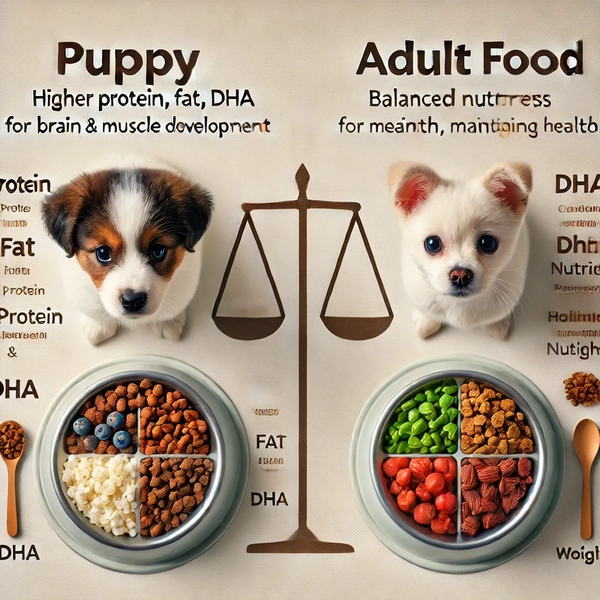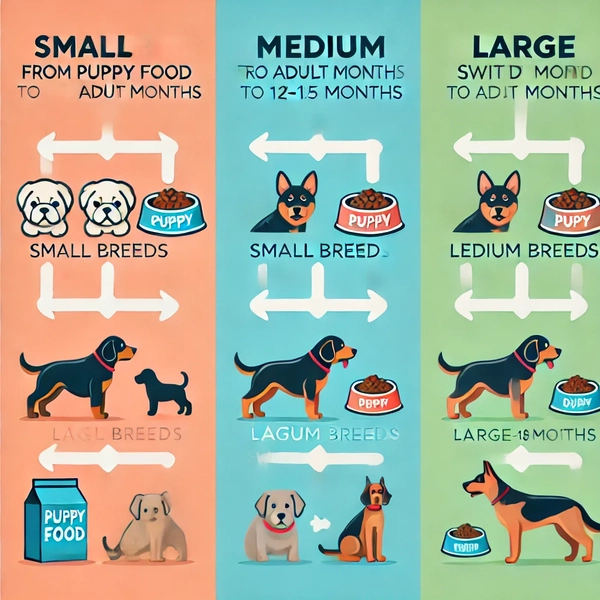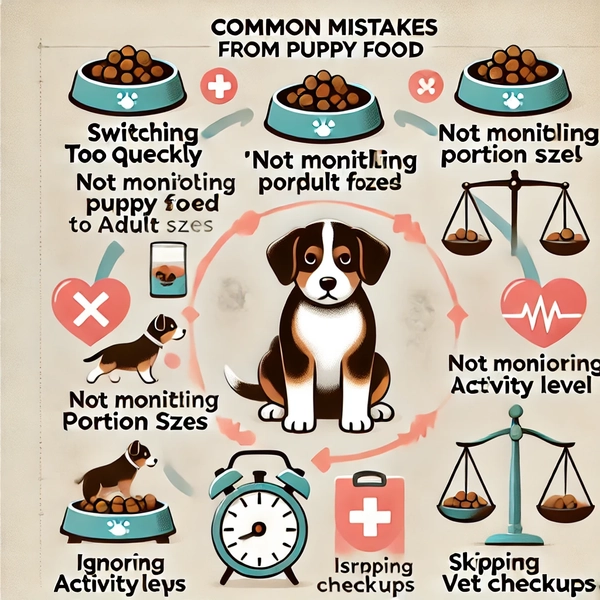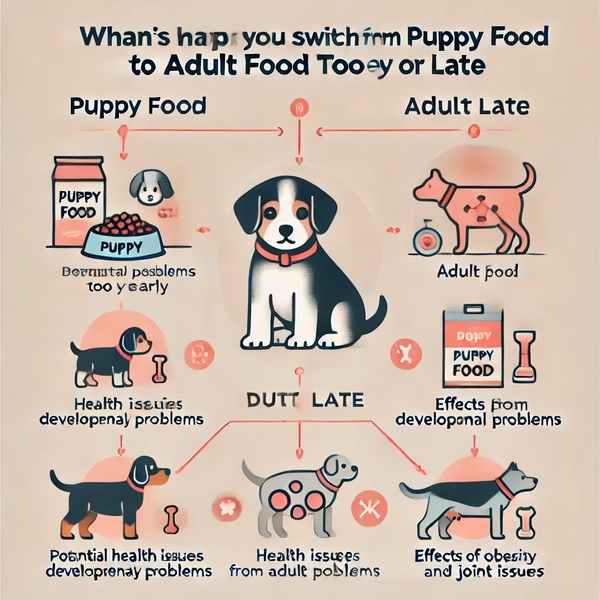When should you switch from puppy food to adult food? The period when you change a dog from eating puppy food to adult dog food is significant in determining its overall health over its lifetime. Think of how you would care for a growing child; a balanced diet must be introduced at the appropriate stage and time.
Puppy And Adult Food: What’s The Differences

Puppy food contains:
- Protein is at higher levels than any other dog food to facilitate the growth of muscles.
- More fats to provide the puppy energy.
- Extra vitamins and minerals such as calcium and phosphorus help form bones.
- DHA, an omega-3 fatty acid, helps develop brain and eyesight.
In turn, adult food aims at:
- It preserves muscle instead of growing it, as with puppy foods.
- They provide lower calorie content since adult dogs usually do not exercise as much as puppies.
- Providing health-packed ingredients to ensure good health without adding any weight.
When Should You Switch From Puppy Food to Adult Food?

Factors to consider:
1. The Size of the Dog
The size of a dog determines when it should switch to adult food. With different breeds, growth is achieved at other times.
- Small Breeds (20 pounds): They usually Switch after 9-12 months. This population of dogs tends to grow faster, so puppy food does not need to be supplied longer.
- Medium Breeds (20-50 pounds): They usually Switch after 12-15 months. Such dogs have a moderate growth rate and are therefore considered to be grown now.
- Large Breeds (50 pounds and above): Switch between 12 and 18 months. The bigger the breed, the longer the age takes for development, and therefore, the need to focus on puppy food is allegories for nurturing bones and joints.
2 Spaying and Neutering
When dogs are spayed and neutered, readily available foods reduce their calorie requirements by almost 20% to 30%. In this case, the switch to adult food may need to be made more quickly than usual to prevent excess weight gain.
3 Levels of Activity
These dogs engage in some work or are sporting breeds and may find it beneficial to delay the change from puppy to grown dog food. This is due to additional food’s significant caloric, nutrient, and muscle development support.
How To Make Transition Without Interrupting The Diet Behavior
Certain complications are associated with changing a puppy’s nutrition from puppy to adult dog food.
Therefore, it is prudent to suggest that this should be done gradually without rushing to avoid possible tummy upsets, such as stomach upsets, diarrhea, or even throwing up.
The transition assists the puppy’s digestive system as it gets used to the newly introduced nutrients.
Day to Day Transition Strategy:
- Days 1-2: Incorporate 25% of the adult food and 75% of the puppy food.
- Days 3-4: Adjust to feed the adult and puppy foods equally at 50%.
- Days 5-6: Increase adult foods to 75% and puppy to 25%.
- Day 7: Only adult foods are given.
This brief methodology helps change your pup’s diet without over-straining its digestion.
Reappraise the adjustments you’ve made if the puppy experiences any of the following effects: vomiting, loss of appetite, or diarrhea during the adjustment period.
For instance, you can give more puppy food for one week, reduce it to the previous amount, and then rear it for a while.
If they persist after those durations, see a veterinarian to eliminate possible other illnesses or issues from their diet.
How to Make the Change Easy
- Firstly, keep the dog under observation. Monitor how your dog reacts to changes made daily.
- Maintain constancy in meal periods. Since the feeding is strictly on schedule, it is easier for the dog’s body to adapt.
- Continue using the same bowl and feeding spot. The change in food is made gradually, but all other factors remain the same to help the dog adjust.
- Praise your pet after feeding it. To reinforce good behavior, you may give the dog praise or a small treat after it eats its food.
- Make sure the circulation is adequate. Diet changes can make these pets thirsty, so ensure all pets are provided with plenty of clean water.
Common Mistakes to Avoid

When getting your puppy used to a new diet, some common mistakes can pose serious health problems. Avoid these mistakes:
1. Making A Change So Suddenly
For the puppy’s sake, following a gradual transition process over 7-10 days is advisable. They will need some time to get used to the changes in diet without being put under much stress. Changes made abruptly may lead to rejection of the new food or make them resistant to eating it.
Tip: It is important to note that a new food should constantly be introduced after mixing it with the old one. The purpose of the transition is to aid their digestive system in handling the latest components, thereby avoiding any shock to the system.
2. Not Monitoring Portion Sizes
Puppy food contains many calories since puppies grow and require more energy. After a switch to adult food, controlling portions becomes essential.
The reverse may be true if the dog is an adult; excessive feeding may cause extreme overweight due to a dog’s reduced calorie demands compared to a growing puppy.
Tip: Manage your dog’s portions after transitioning to an adult diet, using the food packaging feeding guidelines as a guide.
Suggest a more helpful tip by providing information to your veterinarian regarding your dog’s activity level and size for specific portion advice.
3. Underestimating Exercise Level
Some dogs have a higher activity level than others. High-energy dogs, those that work, participate in agility competitions, or train, will often need higher-calorie diets.
In contrast, if the client has a sedentary dog, then that dog’s caloric intake may need to be limited, especially with caloric-dense food being fed in large amounts.
Tip: Consider the dog’s energy level. If it is high, you may have to feed them meals with moderate calories, either more of the food or a mixture of adult and puppy food.
4. Disregarding Recommendations from a Veterinarian
This is especially true regarding proper dog nutrition – no diet suits all dog types. Certain dietary requirements may be specific to the dog’s breed, health issues, or personal likings.
Failing to consult a vet on when it can be appropriate to begin feeding your dog adult food may lead to the wrong decision regarding the type of food or the timing of the change.
Tip: Talk to your vet before extensively changing your dog’s diet. Your vet will help you determine when and what foods to incorporate to change your dog’s health requirements.
5. Delaying Switchover
It is not advisable to extend the period of feeding a puppy with puppy food. Obesity and other medical problems may result if this is done. Because young animals require additional energy for growth, puppy food is more concentrated in calories and nutrients.
Those Additional calories can cause excessive weight gain, which might well be harmful to the dog’s joints, heart, and health in general, and will rotate back to when the dog is growing.
6. Choosing the Wrong Adult Food
Adult dog food is different. Depending on the dog’s size, activity level, or even health conditions, many may need help to meet the nutrient requirements appropriately.
Tip: Buy foods that comply with the AAFCO adult dog food standards. Joint care or digestion problems may be particular health issues for your dog, and you should factor them in when selecting adult food.
How to Choose the Right Adult Food
While changing your puppy’s food, knowing how to choose adult food is equally important. Here are some tips to help keep your dog healthy:
1. First, Look for Quality Ingredients
It’s best to look for whole meat protein sources expressed on the labels, such as chicken, beef, or salmon. However, do not buy foods with by-products mentioned as the primary protein source.
2. Check for Balanced Nutrients
Ensure the diet in question conforms to AAFCO for adult dog nutrition requirements. It shall include:
- 18% protein
- 5- 8% fat
- The essential elements include vitamins A, D, and E and minerals, calcium, and phosphorous.
3. Think of Additional Considerations
If a dog has specific health issues, such as joint or digestive disturbances, dog food is intended to meet those needs. For example, some products have glucosamine, which helps with the joints, while others have omega-three fatty acids for the skin and fur.
What Happens If You Switch Too Early or Too Late?

As we stressed earlier, the challenge is the same. Changing foods during a dog’s growth phase can seriously affect its health.
Switching Habits Too Early
Too often, people let themselves be carried away and make changes too soon. With this, your young dog risks being deprived of certain essential food nutrients that, if provided, would ensure optimum growth. This could lead to:
- Problems with bones and locating structures (great dog breeds particularly).
- The phase of attaining growth furthers within their underlying frames.
- Lack of DHA results in abnormality in the brain and eye structures.
Switching Food Too Late
There are downsides on the opposite spectrum as well. For instance, below are some of the effects of prolonged feeding of puppy food:
- Additional body fat changes result in problems with being overweight.
- Atypical Orthopedic Disorders (AOD) appear due to the limited foods provided in giant breeds.
- Over-nutrition is related to the high content of fat and protein.
In Conclusion, Puppy-to-adult dog food transition is undoubtedly one of the dog care practices meant to facilitate the long-term retention of dog health.
Deciding the correct age to change breeders, age, dog activity, or even neutering a dog is possible. Also, change the agent gradually to prevent tummy upset, and seek your veterinary doctor’s advice to ensure you take good care of your dog.
Nutrition served promptly will ensure your puppy becomes a healthy, complete, whole dog!